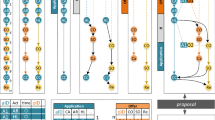Abstract
Case-based reasoning has played an important role in legal reasoning systems. As one criteria for similarity of cases, temporal relationsamong affairs in legal cases should be compared. Thus far in many legalreasoning systems, cases have been described as sequences of pointwiseevents, or at best, simple time intervals, and they have been related bypredicates such as before, after, while,and so on. However, such relations may depend on each implementer'spersonal view, and also require much labor to write down by hand. In this paper, we first propose a classification of affair types by their temporal features, and according to those types, we propose several assumption rules that prescribe the temporal relations between affair types. The temporal relations are automatically generated by these rules. Thereafter, we discuss how thesetemporal relations work in the comparison of similarity of cases. Inthe process of comparison, inadequate temporal relations need to beamended. For this purpose, we introduce revision rules, that refute theresults of assumption rules.
Similar content being viewed by others
References
Allen, J. F. (1984). Towards a General Theory of Action and Time. Artificial Intelligence 23: 123–154.
Ashley, K. (1990). Modeling Legal Argument. Cambridge, MA: MIT Press.
Berman, H. J. & Hafner, C. D. (1993). Representing Teleological Structure in Case-Based Reasoning. In Proceedings of the Fourth International Conference on Artificial Intelligence and Law.
Binnick, R. I. (1991). Time and the Verb. Oxford: Oxford University Press.
Branting, L. K. (1990). Integrating Rules and Precedents for Classification and Explanation: Automating Legal Analysis. Ph.D. Thesis, University of Texas at Austin.
Comrie, B. (1976). Aspect. Cambridge University Press.
Cooper, R. (1986). Tense and Discourse Location Situation Semantics. Linguistics and Philosophy 9(1): 17–36.
Dowty, D. (1979). Word Meaning and Montague Grammar. Dordrecht, Holland: Reidel.
Gardner, A. (1984). An Artificial Intelligence Approach to Legal Reasoning. Ph.D. Thesis, Stanford University.
Gunji, T. (1992). A Proto-Lexical Analysis of Temporal Properties of Japanese Verbs. In Park, B. S. (ed.) Linguistics Studies on Natural Language, 197–217. Hanshin Publishing.
Kamp, H. (1979). Events, Instants, and Temporal References, 376–417. Springer-Verlag.
Kowalski, R. & Sergot, M. (1986). A Logic-Based Calculus of Events. New Generation Computing 4: 67–95.
McCarty, L. C. (1989). Computing with Prototypes. In Proceedings of the Bar-Ilan Symposium on the Foundations of Artificial Intelligence.
McCarty, L. C. (1990). Artificial Intelligence and Law: How to Get There from Here. In Workshop Notes of the Legal Reasoning Workshop of the Eighth National Conference on Artificial Intelligence.
McDermott, D. V. (1982). A Temporal Logic for Reasoning about Processes and Plans. Cognitive Science 6: 101–155.
Moens, M. & Steedman, M. (1988). Temporal Ontology and Temporal Reference. Computational Linguistics 14(2): 15–28.
Nitta, K., Ohtake, Y., Maeda, S., Ono, M., Ohsaki, H., & Sakane, K. (1992). Helic-II: A Legal Reasoning System on the Parallel Inference Machine. In FGCS '92, 1115–1124.
Parsons, T. (1990). Events in the Semantics of English. MIT Press.
Rissland, E. & Skalak, D. (1991). Cabaret: Rule Interpretation in a Hybrid Architecture. Man-Machine Studies.
Shoham, Y. (1988). Reasoning about Change. MIT Press.
Tojo, S. & Wong, S. (1994). A Legal Reasoning System Based on Situation Theory. In Fourth Conference on Situation Theory and Its Applications.
Vendler, Z. (1957). Verbs and Times. Philosophical Review 66: 143–160.
Author information
Authors and Affiliations
Rights and permissions
About this article
Cite this article
Tojo, S., Nitta, K. Similarity of Legal Cases: From Temporal Relations of Affairs. Artificial Intelligence and Law 5, 161–176 (1997). https://doi.org/10.1023/A:1008267913065
Issue Date:
DOI: https://doi.org/10.1023/A:1008267913065




